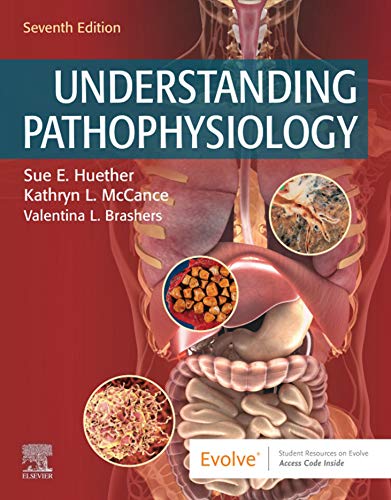Understanding Pathophysiology 7th Edition Huether Test Bank
- Chapters: 44
- Format: PDF
- ISBN-13: 978-0323639088
- ISBN-10: 0323639089
- Publisher: Mosby
- Authors: Sue E. Huether, Kathryn L. McCance
In Stock
Original price was: $55.00.$15.00Current price is: $15.00.
Understanding Pathophysiology 7th Edition Huether Test Bank
Test Bank for Understanding Pathophysiology, 7th Edition by Huether
The Test Bank for “Understanding Pathophysiology, 7th Edition” by Sue E. Huether is a valuable study resource designed to support students, educators, and healthcare professionals in mastering the concepts of pathophysiology. This test bank provides a comprehensive set of practice questions and detailed explanations that align with the textbook, aiding in exam preparation and reinforcing understanding of key pathophysiological principles.
Overview
Purpose and Use
- Comprehensive Review: Offers an extensive review of pathophysiology concepts, including disease mechanisms, manifestations, and management strategies.
- Exam Preparation: Assists students and professionals in preparing for exams, licensure tests, and certification with a variety of practice questions and detailed rationales.
- Concept Reinforcement: Enhances understanding of pathophysiological processes through detailed explanations and examples.
Question Types
- Multiple-Choice Questions: The primary format, covering a wide range of topics related to pathophysiology, including disease processes, symptoms, and treatments.
- True/False Questions: Assess the accuracy of statements related to pathophysiological concepts and disease mechanisms.
- Fill-in-the-Blank Questions: Test knowledge of specific terms, definitions, and pathophysiological concepts.
- Short-Answer Questions: Require detailed responses and explanations about disease processes and their impact on the body.
- Matching Questions: Match pathophysiological terms with their definitions or related disease conditions.
Answer Rationales
- Detailed Explanations: Each question includes a comprehensive rationale explaining the correct answer and the reasoning behind it.
- Conceptual Understanding: Provides context to deepen comprehension of pathophysiological concepts and their applications.
Key Features
Comprehensive and High-Yield Content
- Key Topics Covered: Includes essential topics such as cellular pathology, inflammation, immune responses, and specific disease processes.
- Current Information: Reflects the latest research, guidelines, and best practices in pathophysiology.
Clear and Concise Format
- Organized Structure: Questions and answers are presented in a clear, user-friendly format for effective study and review.
- Visual Aids: May include charts, diagrams, and tables to support understanding of pathophysiological concepts and disease processes.
Interactive and Engaging
- Active Learning: Practice questions promote active recall and application of pathophysiology knowledge.
- Study Tools: Flashcards, quizzes, and mnemonics may be included to reinforce key concepts.
Key Topics Covered
Cellular Pathology
- Cell Injury and Death: Understanding mechanisms of cellular injury, apoptosis, and necrosis.
- Adaptive Responses: Cellular adaptations to stress, including hypertrophy, hyperplasia, atrophy, and metaplasia.
Inflammation and Healing
- Inflammatory Responses: Mechanisms of acute and chronic inflammation, including the role of inflammatory mediators and cellular responses.
- Wound Healing: Stages of wound healing and factors influencing the healing process.
Immune System Disorders
- Immune Responses: Overview of the immune system’s role in health and disease, including innate and adaptive immunity.
- Autoimmune Diseases: Mechanisms and examples of autoimmune disorders, including rheumatoid arthritis and lupus.
- Immunodeficiency: Understanding primary and secondary immunodeficiencies, such as HIV/AIDS.
Pathophysiology of Specific Diseases
- Cardiovascular System: Disease processes affecting the heart and blood vessels, including hypertension, coronary artery disease, and heart failure.
- Respiratory System: Pathophysiology of respiratory disorders, including asthma, chronic obstructive pulmonary disease (COPD), and pneumonia.
- Digestive System: Disorders of the gastrointestinal tract, including peptic ulcer disease, inflammatory bowel disease, and liver disorders.
- Renal System: Pathophysiology of renal diseases, including acute and chronic kidney disease and urinary tract infections.
- Endocrine System: Disorders of the endocrine glands, including diabetes mellitus, thyroid disorders, and adrenal insufficiency.
- Nervous System: Pathophysiology of neurological disorders, including stroke, multiple sclerosis, and Parkinson’s disease.
Genetics and Disease
- Genetic Disorders: Understanding genetic contributions to disease, including inherited conditions and genetic mutations.
- Epigenetics: The role of epigenetic changes in disease development and progression.
Environmental and Lifestyle Factors
- Environmental Influences: Impact of environmental factors, such as toxins and pollutants, on health and disease.
- Lifestyle Factors: The role of lifestyle choices, including diet, exercise, and smoking, in the development and management of disease.
Benefits of the Guide
For Students and Practitioners
Focused Learning
- High-yield questions and rationales focus on critical aspects of pathophysiology.
- Simplified explanations and visual aids enhance understanding and retention of complex concepts.
Efficiency and Convenience
- Organized format allows for efficient study sessions, maximizing use of study time.
- Portable notes and questions can be used for review anytime and anywhere.
Confidence Building
- Practice questions and detailed rationales build confidence and reduce exam anxiety.
- Comprehensive preparation ensures readiness for exams and practical application in clinical settings.
For Educators
Supplemental Teaching Tools
- Test bank questions can complement lectures and course materials, enhancing the learning experience.
- Use of questions and rationales in classroom activities and assessments supports student learning.
Assessment and Feedback
- Practice questions help assess students’ understanding and progress.
- Detailed rationales provide constructive feedback and opportunities for improvement.
Practical Applications
Self-Study and Review
- Use the test bank for focused self-study sessions to reinforce fundamental concepts in pathophysiology.
- Quick review sessions with concise questions and rationales to consolidate learning.
Group Study Sessions
- Collaborate with peers using practice questions and rationales for interactive learning.
- Use the test bank during group discussions and study sessions to enhance understanding.
Exam Preparation
- Thorough preparation with comprehensive practice questions and detailed explanations.
- Practice with realistic questions to ensure readiness for exams and practical assessments.
Conclusion
The “Test Bank for Understanding Pathophysiology, 7th Edition” by Sue E. Huether is an essential resource for students and professionals in the field of pathophysiology. With its comprehensive coverage, detailed rationales, and effective study strategies, this test bank provides a thorough approach to mastering the principles and applications of pathophysiology. Whether used for self-study, group activities, or exam preparation, these resources support individuals in achieving success in their educational and professional pursuits in understanding and applying pathophysiological concepts.


Reviews
There are no reviews yet.